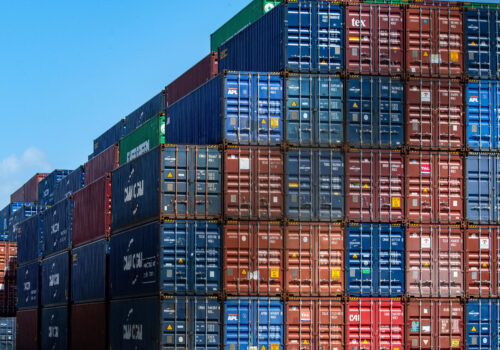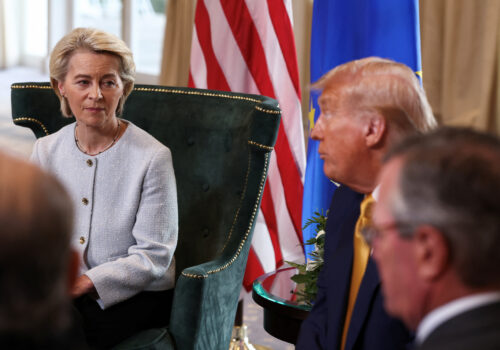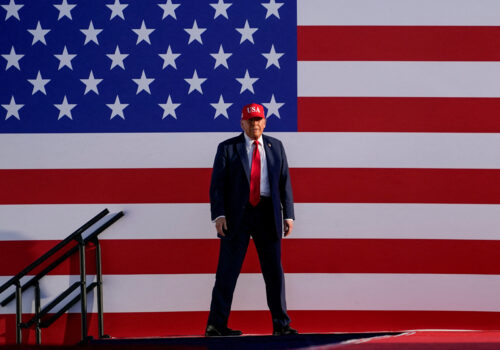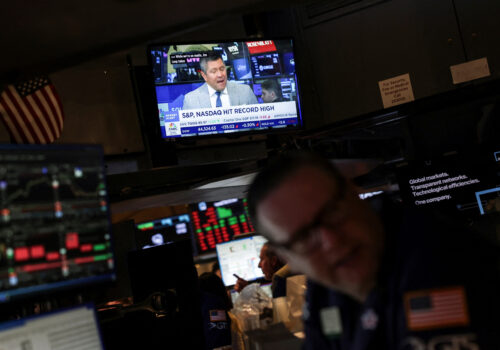Trump and von der Leyen made a deal. But the US and EU are drifting apart on trade.
For European Commission President Ursula von der Leyen, Sunday’s announcement of a trade deal with US President Donald Trump should be seen as a personal triumph. She took the risk to travel to Scotland, knowing that only Trump could seal the deal; after all, he had responded to an earlier deal negotiated with his cabinet officials and based on a 10 percent baseline tariff by sending a letter to the European Union (EU) threatening 30 percent tariffs. His unpredictability and their lack of a solid relationship made the outcome uncertain—50/50 at best, as both presidents acknowledged. Yet they still managed to produce an agreement to ensure that the largest economic partnership in the world—worth $1.7 trillion in trade annually—will not be disrupted by a massive trade war. But unlike many trade deals that herald a closer relationship between the parties, this one is more likely to push the EU farther away from its longtime partner.
For Trump, he had the optics of EU leadership coming to his Turnberry golf resort and reaching a deal based largely on his terms (but not his worst threats). As he said during his press conference with von der Leyen, this was a big deal, a deal with the United States’ largest trading partner. Indeed, his comments during the joint press conference were probably the most respectful and positive on the EU that he has ever made.
The Turnberry deal has clearly demonstrated that the EU should not expect any favors from the United States.
That hasn’t stopped a backlash from forming in some European quarters. On Monday, French Prime Minister François Bayrou said, “It is a dark day when an alliance of free peoples, united to assert their values and defend their interests, resigns itself to submission.” German Chancellor Friedrich Merz and Italian Prime Minister Giorgia Meloni welcomed the deal, although Merz later noted there would be costs for the German economy. Yet, the EU member states will almost certainly hold their noses and approve the deal when it is put before them.
Despite these different opinions, everyone around the European Council table is well aware that deals with Trump contain many uncertainties and ambiguities. The Turnberry deal is not the end, but just a framework for further negotiations. There is, for example, a lack of clarity over those sectors subject to an investigation under Section 232 of the Trade Expansion Act of 1962, including semiconductors and pharmaceuticals. While it appears that EU pharma exports to the United States, which totaled €120 billion in 2024, will be covered by the 15 percent tariff rate, Trump himself cast doubt on that during the press conference. Only after the Section 232 investigation is concluded is there likely to be predictability for pharma. On steel, Trump said that the current 50 percent tariffs will continue to apply, while von der Leyen has indicated that tariffs will be reduced and a quota established based on historical averages.
There is also little clarity about tariff reductions that von der Leyen mentioned in her statement but that the United States did not mention with any specificity. These include aircraft, certain chemicals and generic drugs, as well as some agricultural products and critical raw materials. Instead, the White House fact sheet on the deal mentions removing European non-tariff barriers, a topic on which von der Leyen was silent. Negotiations to finalize these points are likely to be lengthy and challenging.
Trump also placed much emphasis on an apparent EU pledge of $600 billion in new investments into the United States, which was also the first point on the US fact sheet. Most likely, this is just an adding up of existing pledges by European companies. The German carmaker Volkswagen has committed twenty billion dollars and British-Swedish drugmaker AstraZeneca fifty billion dollars, for example. It would be extremely unlikely that the EU itself would provide investment capital for companies that seek to move to the United States. Von der Leyen’s statement was remarkably silent on this point, raising questions about this element of the deal. The EU has also pledged to purchase $750 billion of US energy exports over the next three years (an average of $250 billion per year), even though total US energy exports in 2024 were valued at $332 billion. Will the EU take over the bulk of US energy exports? That seems unrealistic.
But there is one certain outcome of this deal: It will further incentivize the EU to turn toward a version of economic security that is wary of the United States. European leaders will accept the 15 percent tariff because it is better than the threatened 30 percent, but they will remember that it was the United States that began this round of tariff hikes. The EU will put even more energy into opening other markets and ensuring that they are not dependent on the partner across the Atlantic.
During her press conference, von der Leyen pointedly mentioned recent deals with Indonesia, Mexico, and the South American trade bloc Mercosur, as well as the ongoing negotiation with India. And while Sunday’s deal includes pledges to buy huge amounts of energy, as well as weapons and other defense materiel, many in Europe are likely to see these as temporary and necessary evils. Europe will use US energy (although not as much as pledged) to reduce an even more destructive dependence on Russia. But few in Europe see US liquefied natural gas as the permanent solution that home-grown renewable energy might provide. Defense purchases are essential for Ukraine and Europe (and would likely have happened without this deal). But European governments are increasingly looking to their own insufficient defense industrial base and asking what is needed to meet Europe’s geopolitical challenges alone.
The Turnberry deal has clearly demonstrated that the EU should not expect any favors from the United States. That will be underlined by the need to finalize many elements over the next few months. As the British have discovered, getting promised agreements from the US side can be challenging, especially if Trump is distracted elsewhere or even simply changes his mind. No one in Europe should be surprised when these ambiguities and differences reemerge. It will just be another signal that the United States is no longer a reliable partner and that Europe’s economic future lies with others.
Frances Burwell is a distinguished fellow at the Atlantic Council’s Europe Center.
Further reading
Sun, Jul 27, 2025
How big a deal is the new US-EU trade announcement?
Fast Thinking By
Our experts unpack the framework for a trade deal announced by US President Donald Trump and European Commission President Ursula von der Leyen on Sunday in Scotland.
Tue, Jul 8, 2025
April, July, now August: Our expert guide to Trump’s latest tariff moves
New Atlanticist By
“Liberation Day” was nearly ninety days ago, and now the deadline for many nations to negotiate a trade deal and avoid US tariffs is extended to next month. Atlantic Council experts explain what’s behind the moving calendar.
Tue, Jul 15, 2025
Beware the ‘dangerous disconnect’ between Trump and the markets on tariffs
Inflection Points By Frederick Kempe
The US president’s approach to tariffs is about leveraging the United States’ economic power for ends that go beyond trade.
Image: US President Donald Trump shakes hands with European Commission President Ursula von der Leyen, after an announcement of a trade deal between the U.S. and EU, in Turnberry, Scotland, Britain, July 27, 2025. REUTERS/Evelyn Hockstein/File Photo




